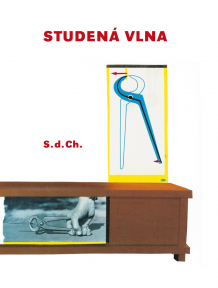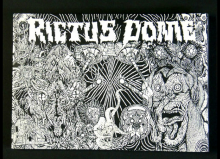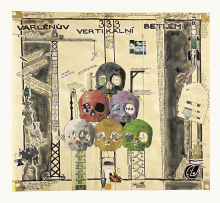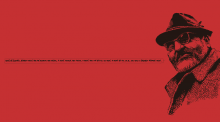| Umělec magazine 2009/2 >> Inoperative Utopia: New Collages by Volker Eichelmann at the Andreas Huber Gallery, Vienna | List of all editions. | ||||||||||||
|
|||||||||||||
Inoperative Utopia: New Collages by Volker Eichelmann at the Andreas Huber Gallery, ViennaUmělec magazine 2009/201.02.2009 Tom Holert | koláž | en cs de |
|||||||||||||
|
In common parlance a project proposal is addressed to an audience of experts who are thereby asked and invited to ponder the possibilities and risks of a realization of the proposed. Due to their generic status as proposals for sculptures and buildings, Volker Eichelmann’s new collages, shown along with sculptures by Manuela Leinhoß at the Vienna-based Andreas Huber Gallery in the fall of 2008, inevitably enter a process of assessment, or examination or—as they say in architecture departments—of crits. The cultural (and academic) tradition of applying for grants, connected with the term proposal, is in this case already subject to a reflection on the genre of proposal itself, resulting in Eichelmann’s collages. Because there seems to be no commission for creating a sculpture in public space and no architecture competition that Eichelmann is applying for, it is primarily the collages themselves that are up for examination. Titles like Entrance to a Flea Market (No Charge), Freilichtskulptur (Teutoburger Wald), Hagenbeck (Moderne Autoren III), Kunsthalle Winterthur, Café, Cinema or Surfbude Cornwall bespeak more-or-less specific problems and functions. The rather small cut-and-paste works done on cardboard (mostly measuring 32 x 22.5cm; the single exception in the exhibition is a large collage also belonging to a different group of works, the large-sized collage, A Respectable Pastime, 2008) are at the same time the cause and solution of the task.
Presumably, the site of this coincidence is the artist himself, who was born in Hamburg in 1973 and has been living and working in London for a long time. But the “autopoietic” principle of certainly has its limits. The collages, in their often Constructivist conception, refer to the heroic epoch of modernity in which utopia and order were not mutually exclusive. In the 1920s, El Lissitzky and Kasimir Malevich confronted the task of creating a revolutionary town for the revolutionary masses, a social imaginary, a form of collectivity in which they may have imagined themselves to be in line with the powers of the Party and history. Eichelmann’s collages look back on a long history of utopian and fictional paper architecture. They cite—often ironically, sometimes fussily humorously—Bruno Taut, Paul Scheerbart, Hermann Finsterlin, Constant, Archigram, Haus-Rucker and many others. Eichelmann also takes samples from the long line of various, un-materialized major sculptural projects. Of course, art—and particularly the monumental outdoor sculpture—can look back on a remarkable history of works that have never been realized. The archive of memorials that have not gone beyond the stage of draft, conception, or model is boundless and has not been examined thoroughly. How many “designs of a public sculpture” and “studies for outdoor constructions” are tucked away in the stacks of the 20th century avant-gardes? They have never been counted, but some of them experienced interesting receptions. One of the most famous of those virtual sculptures is Vladimir Tatlin’s Monument for the Third International, a model, four meters in height, made in 1919 in Petrograd and shown there publicly in 1920 as well as in Moscow, before it made its way through the whole Soviet Union and eventually arrived in Paris in 1930. Until today, the imaginary and counterfactual verve of this legendary draft of a skyscraper sculpture has been floating through collective memory. Eichelmann devoted himself to the sub-history of past futures and forgotten or suppressed science fiction that sometimes isn’t aware of its own status as a tale of times to come. In this way, he did not only archive the allegedly functionless artificial grotto and folly architectures of 18th century British Aristocracy (Follies & Grottoes, 2003-2006), but also discovered the idiosyncratic creationism of the paper-découpages by Mary Delany produced in the same century. Dealing with the botany enthusiast led to a series of collages in 2005 containing over 160 pages. In a quasi-genetic experiment based on existing and widespread plant photography, Eichelmann “created” just as many unknown plants. The fact that in these works we may assume not only a comment on biotechnological practices, but also on the latest art and science hype, adds a caustic touch to these seemingly harmless pages. The recent collages of the proposals-series also play with fantasies of omnipotence that from time to time cross the “legend of the artist”: imaginations of unlimited feasibility and consequential gluttony develop a stirringly fragile effect after having been reduced to the modest, domestic format preferred by Eichelmann. Tinkering and detail-cutting, the unheroic work with scissors and paper has always been a dimension within the history of collages, even though it was often kept back. With good reason, the 20th century’s annus mirabilis of this history is said to be the year 1912, when Picasso combined newspaper clippings and wallpaper leftovers with chalk and gouache in his cubistic papier collés. Since then, the collage has advanced to being a cultural technique, exceeding by far the manageable scope of paper and scissors technology. It has become the aesthetic design principle of confrontation and heterogeneity. In a Brian Aldiss review of 1973, re-printed in a book with a title that would fit Eichelmann’s recent works perfectly well (Archaeologies of the Future. The Desire Called Utopia and Other Science Fictions, London/New York 2005), Fredric Jameson calls the collage an “organizing procedure” of science fiction literature. “In the worst case, collage results in a way of desperately pasting together everything close at hand; in the best case though, it operates as a form of emphasizing older genre models as a kind of distancing effect that has an impact on our receptivity of the generic.” Eichelmann’s collages pursue this effect. They activate an allegedly familiar but also discarded mode of utopian designing and put it in the context of an alleged uselessness: as a decidedly inoperative utopia.
01.02.2009
Recommended articles
|
|||||||||||||
|
04.02.2020 10:17
Letošní 50. ročník Art Basel přilákal celkem 93 000 návštěvníků a sběratelů z 80 zemí světa. 290 prémiových galerií představilo umělecká díla od počátku 20. století až po současnost. Hlavní sektor přehlídky, tradičně v prvním patře výstavního prostoru, představil 232 předních galerií z celého světa nabízející umění nejvyšší kvality. Veletrh ukázal vzestupný trend prodeje prostřednictvím galerií jak soukromým sbírkám, tak i institucím. Kromě hlavního veletrhu stály za návštěvu i ty přidružené: Volta, Liste a Photo Basel, k tomu doprovodné programy a výstavy v místních institucích, které kvalitou daleko přesahují hranice města tj. Kunsthalle Basel, Kunstmuseum, Tinguely muzeum nebo Fondation Beyeler.
|




































 New book by I.M.Jirous in English at our online bookshop.
New book by I.M.Jirous in English at our online bookshop.
Comments
There are currently no comments.Add new comment